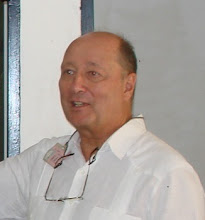”Tipa tipa, ti zwazo fe nish li”. Bit by bit, the tiny bird makes her nest, says the Kreyol proverb, and in this season it is truer than ever. At the start of the rainy season, birds make their nests to prepare for the safe hatching of their young.
One type of bird, a tiny yellow bird, converges in flocks into a single tree, screeching in a volume totally out of proportion to their small size, as they fly back and forth from the palmier trees, where they pluck the slender fibrous leaves to build their nests. They are called "Madame Sara” birds, because they make as much noise as the ladies at the Verettes market, calling out to each other to advertise their wares and to belittle the meager offerings of their neighbors.
One can almost imagine what the tiny birds are saying, as they hover next to their nests, which hang from branches, gradually becoming a gourd-like structure with a side entry. They fly to the nest with leaves, and pound them into the next row, using ther beaks almost like nail hammers. “Come on, girls, time’s a-wasting, the rains are coming, we have to get our chicks under shelter.”
 The rainy season also brings out the maternal instincts of the women of the mountains, who come to the hospital with their sick and malnourished children, where they are admitted first to the pediatrics ward for initial treatment and then to the Nutrition Rehabilitation Unit to regain some of their lost weight, and to receive psychosocial intervention.
The rainy season also brings out the maternal instincts of the women of the mountains, who come to the hospital with their sick and malnourished children, where they are admitted first to the pediatrics ward for initial treatment and then to the Nutrition Rehabilitation Unit to regain some of their lost weight, and to receive psychosocial intervention. Since May, the population of the NRU has doubled, reflecting the dire conditions in the upland communities. The year’s food supply comes from a single planting season; last summer’s crops have all been consumed, and hungry families watch the slender green shoots of corn and millet emerge from the rocky soil, knowing that it will be weeks before they can be harvested. They watch hopelessly as their children lose weight, and their stomachs become distended with parasites. Then they bring them to the health centers in Bastien or Tienne, or directly to the hospital, where the children will be treated and given life-saving food.
For many years, HAS has weighed all children under 5 years old, and have treated children whose weights are below normal either in community-based 2 –week nutrition sessions (ti foyers), or at the hospital if the condition is more severe. This year, HAS has embarked on an innovative approach; women volunteers who support approximately 15 households each (called animatrices), go to each of their assigned families to conduct a Risk Factor Assessment to identify households where children are at a high risk for malnutrition or diseases. Because many of the animatrices are illiterate, the assessment form is a series of graphics, which the visitor checks off when they see them. They report on the condition of the house and courtyard, where the family cooks, whether they have a latrine, and how they access water.
The categories were defined in focus groups with animatrices, and field tested and revised before the campaign started. With support from the UN OCHA program, every household in the HAS service area with a child under 5 years will be assessed, and children in these households will be offered supplemental foods to try to prevent the annual increase in cases of severe malnutrition. Our hope is to be able to prevent malnutrition in the highest-risk households, and to be able to show, over several years, a decreasing trend in severe malnutrition and a reduction in referrals to the hospital during the rainy season.
With tiny steps, the hospital continues to build a system which addresses the immediate needs of the people in the Artibonite Valley, and to establish a foundation to change the major patterns of disease, particularly in the most vulnerable of the mountain communities.
Ian Rawson,
17 June 2010.






